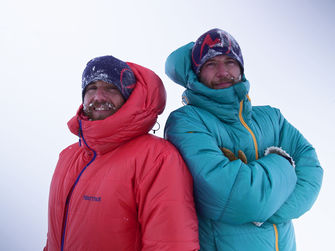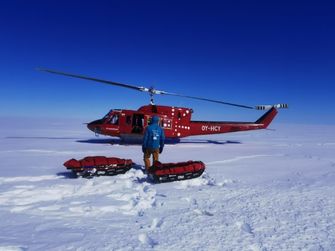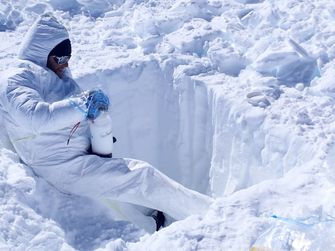This unique triathlon adventure will collect valuable environmental data about Greenland for three renowned Belgian research centers
Solvay is supporting the Nanok expedition, a sporting adventure project in Greenland that will help advance scientific research on climate carried out at three Belgian research centers. The expedition is about to start and involves two Belgian explorers, Gilles Denis and Nathan Goffart, who plan to collect a series of samples for climate research while completing a unique triathlon challenge.
The Nanok expedition will last five months and be carried out completely autonomously. The explorers will cross the icy and deserted expanses of the ice cap along the wild south east coast of Greenland, known for its polar bears ("Nanok" or "nanoq" in Inuit language). The triathlon they will complete involves:
- a 600km ski-sled (pulka) crossing of the ice sheet along the Arctic Circle;
- a more than 1,000km sea kayak descent along Greenland’s east coast;
- a 1km vertical ascent to open a new climbing route.
Throughout the journey, the two explorers will collect environmental data for the Royal Observatory of Belgium (ROB), the Université Libre de Bruxelles (ULB) and the Université de Liège (ULg). This includes:
- Data collected by a GNSS receiver attached to the adventurers’ sleds, which will be used by the ROB to calibrate elevation models and satellite data in Greenland as the adventurers cross the ice sheet.
- The collection of snow and cryoconite samples for the ULB to study the role of dust in algae growth and extension on the Greenland ice sheet, and on the accelerated rate at which it is melting. ULB scientists will also assess the impact of microplastics on remote seawater along the east coast of Greenland.
- Snow pit measurements of winter snowfall accumulation over the Greenland ice sheet, which the ULg and the Ecological Commission of Denmark and Greenland will use to validate estimates of the modelled surface mass balance.
"Nanok is the embodiment of Solvay’s purpose to bond people, ideas and elements to reinvent progress,” said Solvay’s Corporate Citizenship Manager, Sonsoles Llopis Garcia. “It involves two young people in search of meaning who want to add an extra dimension to their adventure by contributing to scientific progress. We are thrilled to participate in what is both an extraordinary human challenge and a unique scientific expedition.”
What the Nanok expedition means to the 3 belgian research centers
"The Nanok project is something that gives meaning to what we do. We use our public domain skills for research. We use our expertise in original fields to bring something new to the table," said Bruno Bertrand, Head of the Time Office at the Royal Observatory of Belgium.
"Using the tools we have developed, we will be able to understand the dust deposition processes, and dust deposition processes, and dust deposition processes give us an idea of atmospheric paleo-circulation,” said Steeve Bonneville, a researcher at the Université Libre de Bruxelles. “When we look back at major climatic changes, the study of dust gives us an idea of the position of the winds, and from there, how the climate reacted to sudden climatic variations."
"The only measurements we have in Greenland come from satellite data that is sensitive to clouds and so on; in other words, 30 or so weather stations spread over an area that is four or five times the size of France, and therefore obviously do not accurately represent the climate there,” said Xavier Fettweis, professor of climatology at the University of Liège. “The adventurers are going to go to areas where, in most cases, no one has been before. We obviously need validation data to validate the model. This is the scientific interest that I see in the Nanok expedition."
Solvay is one the main sponsors of the Nanok expedition, perpetuating Solvay Founder Ernest Solvay’s lifelong passion and support for scientific research through partnerships and collaborations with universities. It is part of the Group’s corporate citizenship program which aims to address worldwide societal challenges by supporting projects in three distinct areas: STEM (Science, Technology, Engineering and Mathematics) education, innovation and sustainability. In particular, the program aims to encourage the development and improvement of scientific knowledge, investing in extraordinary projects that go beyond and pursue ideas that are outside the box.
The funding Solvay provided for the expedition has been used to purchase the equipment necessary for the scientific experiments and measurements, including two sleds and two sturdy sea kayaks that can carry measuring equipment securely, solar panels, batteries and cables to recharge measuring instruments, and a telephone or satellite modem to communicate with researchers and the media. It was also used to purchase the equipment necessary for documenting the trip, such as cameras, lenses and microphones, and to fund test and training trips.
Related media
Media contacts
Solvay’s Corporate Citizenship program aims at making a positive impact on society at large. The contributions made are derived from our technologies, solutions, and innovations, as well as the Group’s spirit of service and giving. To that end, Solvay remains deeply committed to philanthropic endeavors via contributions to worldwide societal challenges by supporting projects in three distinct areas: Protecting the Planet, Nurturing Innovation and Fostering Education. The initiatives in each of these three categories are closely aligned with the Group’s business, including active involvement in several flagship endeavors that truly reflect the way Solvay partners with its stakeholders. More information on corporate-citizenship.solvay.com.
Solvay is a science company whose technologies bring benefits to many aspects of daily life. With more than 21,000 employees in 63 countries, Solvay bonds people, ideas and elements to reinvent progress. The Group seeks to create sustainable shared value for all, notably through its Solvay One Planet roadmap crafted around three pillars: protecting the climate, preserving resources and fostering a better life. The Group’s innovative solutions contribute to safer, cleaner, and more sustainable products found in homes, food and consumer goods, planes, cars, batteries, smart devices, health care applications, water and air purification systems. Founded in 1863, Solvay today ranks among the world’s top three companies for the vast majority of its activities and delivered net sales of €10.1 billion in 2021. Solvay is listed on Euronext Brussels and Paris (SOLB). Learn more at www.solvay.com.













